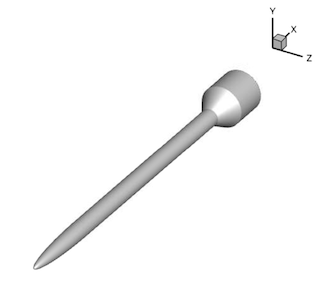

A computational campaign was performed to match a series of experiments on turbulent flow at Mach 2.85. The experiments were carried out in the 1980s at NASA Ames Research Center on a set of cone / skewed flare configurations designed to produce highly three-dimensional shock-wave / boundary-layer interactions in the absence of end-wall effects. Both Reynolds-average Navier-Stokes computations and detached eddy simulations were completed. Difficulty in capturing the correct separation bubble size was encountered with initial detached eddy simulations, but the introduction of resolved turbulence via a boundary layer trip produced much better results.
The experimental configuration consisted of a nose region, followed by a 50.8 mm circular cylinder. The length of the initial nose / cylinder region was about 1.0 m. A 30 deg half-angle flare was integrated with the end of the cylinder. Four flare inclination angles were considered: 0 deg (axisymmetric), 5 deg, 10 deg, and 23 deg.
Two of the configurations are shown below. The test article in the image on the left is axisymmetric, that is, the flare inclination angle is 0 deg. The one in the image on the right has a flare inclination angle of 23 deg.


The movies below show the instantaneous skin friction magnitude for the detached eddy simulations. The point of view is from the side, and the main flow is from left to right. A high degree of large-scale separation unsteadiness is evident in these flows, particularly for the higher flare inclination angles.
Flare inclination angle: 0 deg
Flare inclination angle: 5 deg
Flare inclination angle: 10 deg
Flare inclination angle: 23 deg
The work has been documented in detail in:
This project was sponsored by DEVCOM-ARL under the AAMP-EM program. This material was cleared for public release on April 9, 2024. Distribution A: Approved for public release; distribution is unlimited.